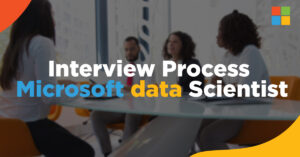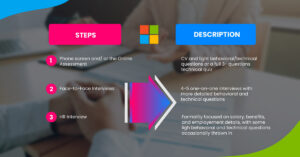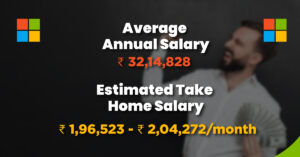Introduction – Microsoft Data Scientist
“The most valuable commodity I know of is information.” – Gordon Gekko
Modern data science has arisen in technology, from enhancing Google search ranks and LinkedIn recommendations to influencing Buzzfeed editors’ headlines. However, it is set to alter all industries, from retail, telecommunications, and agriculture to health, haulage, and the criminal justice system.
However, the phrases “data science” and “data scientist” are not always easily understood, and they are used to cover a wide variety of data-related tasks.
A data scientist is a specialist who collects, analyses, and interprets massive volumes of data. The function of data scientist is an extension of numerous traditional technical occupations, such as mathematician, scientist, statistician, and computer expert. This position necessitates the use of modern analytics technologies such as machine learning and predictive modeling.
Large volumes of data are required for a data scientist to build hypotheses, make conclusions, and assess consumer and market trends. Basic tasks include data collection and analysis, as well as the use of various analytics and reporting tools to find patterns, trends, and linkages in data sets.
Data scientists in business generally work in groups to mine huge data for information that may be used to forecast consumer behavior and uncover new income prospects. In many firms, data scientists are also in charge of establishing best practices for data collection, analysis, and interpretation.
The demand for data science skills has expanded dramatically over the years as businesses seek to derive usable information from big data, the massive volumes of structured, unstructured, and semi-structured data produced and collected by a major corporation or the internet of things.
About Microsoft

Microsoft is the world’s largest vendor of computer software. It also provides cloud computing services, video games, computer and gaming devices, search, and other internet services. Microsoft’s corporate headquarters are in Redmond, Washington, and the company has offices in over 60 countries.
Microsoft’s most famous products are Microsoft Windows, Microsoft Office, Skype, LinkedIn, Internet Explorer, and Edge web browser. For someone working in, or aspiring to work in the data field, a familiarity with products such as Microsoft SQL Server, SQL Server Reporting Services (SSRS), Power BI, and Azure SQL Database too is essential.
Microsoft’s global sales increased by 18 percent year on year from fiscal year 2020 to fiscal year 2021, hitting over 168 billion US dollars. In terms of sales income, this is again another record-breaking year for the software behemoth.
In 2022, Amazon Web Services (AWS) is already handling major workloads for 46 percent of respondents, while Microsoft Azure is a close rival with 45 percent workload.
Microsoft’s Windows operating system is the most extensively used computer operating system in the world, with a 69.61 percent share of the desktop, tablet, and console OS market in December 2021.
Apple’s macOS and iOS are the next most popular operating systems, with the latter being standard on all iPad devices. For people who favor open-source software and want to avoid the influence of big OS developers, Linux OS versions are the best solution.
Also Read: Amazon Data Scientist
Interview Process- Microsoft Data Scientist

Microsoft Data Scientist’s interview procedure, like that of many well-known technological corporations, consists of numerous rounds. To help you perform better in your interview, we’ve produced a broad outline of what to expect. You’ll be more prepared if you know what to anticipate. Microsoft’s interview procedure formerly included both virtual and on-site interviews.
However, because of the COVID-19 epidemic, Microsoft’s official announcement states that all in-person interviews will be conducted digitally. This has no substantial impact on the general layout of the procedure and what you should expect.

When you start the interview process, you should be prepared for the following: There will be one phone screen and assessment, followed by 4-5 on-site interviews (or, better, face-to-face interviews, since the pandemic changed the approach). This is an overview of the procedure:
Phone interview and/or online assessment for Microsoft Data Scientist
The first phase of the interview process in Microsoft is phone screening, which occurs when you receive a call from an HR recruiter or submit a job application. This initial phase normally takes up to 60 minutes and involves speaking with a team member or your future supervisor. Your CV will be reviewed as part of the screening process.
For Microsoft data scientist, then there will be some questions. Depending on the position you apply for, you may be asked many behavioral questions and one easy-to-medium coding, data structure, algorithm, or other technical topic.
The technical question will be evaluated using an online code editor, and you will have 30 minutes to answer it. It’s also possible that your technological abilities will only be evaluated online. This usually lasts up to 90 minutes and consists of three questions.
Face-To-Face Interviews for Microsoft Data Scientist
This round entailed spending the entire day at Microsoft headquarters and conducting four or five interviews. The epidemic has shifted this to entirely virtual interviews. This is the most significant modification. These interviews, like the previous ones, will last one hour and will be conducted one-on-one.
More behavioral and technical inquiries might be expected here. They will be more numerous and more challenging than in the previous round.
The interviews will entail speaking with several members of your potential team who have varying degrees of technical knowledge and skill. The final in-person interview will be with a senior executive who has the authority to disapprove or approve your hire.
Again, the goal of this interview is to ask you some questions (be they behavioral or technical) to ensure that anything that was omitted in earlier interviews is addressed. As a senior executive, the interviewer will also try to persuade you to accept the job offer if one is made.
HR Interview for Microsoft Data Scientist
The HR interview will be the final stage in the interviewing process. This is a more or less formal interview with the human resources employer. You’ll also be asked some behavioral and technical questions here, but mostly to ensure that you’re the proper applicant. You will also address your wage, benefits, and other employment-related subjects during this interview.
Also Read: Google Data Scientis
t Interview
Interview Questions for Microsoft Data Scientist

Microsoft data scientist interview questions fall into four categories:
- Behavioral Questions
- Product Sense & Business Cases
- Data Analysis & Coding
- Modeling Techniques
We’ll include several samples from each area.
Behavioral Questions for Microsoft Data Scientist
These are the questions for Microsoft Data Scientist answered to assess your workplace behavior. How you react in diverse situations, create interpersonal relationships, and perform in various scenarios is important. To be more specific, consider the following:
- Why are you quitting your current position?
- What makes you want to work at Microsoft?
- Describe a situation in which you had to pick up a new technical skill on the job.
- Tell us about some of the most important life lessons you’ve learned.
You must express yourself and promote yourself as a person and a professional here. The most essential thing is to know what you want to say but also how to say it. You might get more information from our article.
Product Sense & Business Cases for Microsoft Data Scientist
You’ll have to demonstrate your knowledge of Microsoft and its products here. You’ll also have to answer questions that demand you think about figures, facts, and estimations.
- Explain recursion to me as though I’m five years old.
- How would you create an alarm clock for the deaf?
- Which Microsoft product is your favorite, and why?
Coding and Data Analysis for Microsoft Data Scientist
These technical questions are intended to assess your theoretical and practical understanding of data analysis, data processing, and code creation. Here are some examples of questions you could be asked at Microsoft:
- Find the total number of downloads by date for both paid and non-paying users.
- We have a table containing employee wages, but some of the records are old and include obsolete compensation information. Determine each employee’s current wage, assuming that salaries rise each year.
- Calculate the amount of project budget allotted to each employee given a list of projects and employees linked to each project.
Modeling Techniques for Microsoft Data Scientist
These questions for Microsoft Data Scientist are designed to put your statistical, mathematical, and model-building skills to the test. Here are some questions you could be asked during an interview:
- How can I construct an inverse matrix more quickly by using certain computational tricks?
- How can you tell if a new observation is an outlier?
- What is the definition of variation?
Skills, Requirements, and Salary- Microsoft Data Scientist
Requirements for Microsoft Data Scientist

Microsoft aims to employ experienced applicants with at least two years of data science expertise for mid-level positions. A Ph.D. in a quantitative subject is required, as well as some years of expertise in any of these domains (DNN, NLP, time series, reinforcement learning, network analysis, or causal inference).
- Previous expertise in DNN, NLP, time series, reinforcement learning, network analysis, causal inference, or other relevant fields is preferred.
- Proficiency in any of the numerical programming languages listed below (Python/Numpy/Scipy, R, SQL, C#, or Spark)
- Knowledge of cloud architectures such as AWS or Azure
Skills Needed to Become a Microsoft Data Scientist

Statistics and Probability for Microsoft Data Scientist
Data Science is the process of extracting knowledge, insights, and making educated decisions from data utilizing capital methods, algorithms, or systems. Making conclusions, estimating, or forecasting are thus fundamental aspects of data science.
Probability, when combined with statistical approaches, aids in the generation of estimates for further investigation. Statistics is mostly based on probability theory. Simply put, they are connected.
Linear Algebra and Multivariate Calculus for Microsoft Data Scientist
The majority of machine learning and data science models are developed using several predictors or unknown variables. Building a machine learning model requires understanding of multivariate calculus. Here are some arithmetic concepts you should be familiar with if you want to work in data science:
- Gradients and derivatives
- Step function, Sigmoid function, Logit function, and ReLU (Rectified Linear Unit) function are all examples of functions.
- The cost function (most important)
- Function plotting
- A function’s minimum and maximum values
- Scalar, vector, matrix, and tensor functions are all examples of functions.
Also Read: TCS Data Analyst
Programming, Software, and Packages for Microsoft Data Scientist
Data science is fundamentally about programming. All of the core skills required to convert raw data into useful insights are covered in Programming Skills for Data Science. While there are no hard and fast rules for choosing a programming language, Python and R are the most popular.
Data scientists select a programming language that meets the requirements of the issue statement at hand. Python, on the other hand, appears to be the closest approach to a data science lingua franca.
Here’s a selection of programming languages and Data Science packages to consider, in no particular order:
- Python
- R
- SQL
- Java
- Julia
- Scala
- MATLAB
- TensorFlow (great for data science in Python)
Data Wrangling for Microsoft Data Scientist
Often, data acquired or received by a firm is not ready for modeling. It is consequently critical to comprehend and know how to cope with data flaws.
Data wrangling is the process of changing and mapping raw data from one form to another in order to prepare the data for future analys
is. You basically obtain data, aggregate important variables, and then purify the data for data wrangling.
Database Management for Microsoft Data Scientist
Data scientists are unique individuals who are masters of all trades. To be a “full-stack” data scientist, they must be knowledgeable in arithmetic, statistics, programming, data management, visualization, and other areas.
Preparing the data for processing in an industrial environment accounts for 80% of the job. With heaps and enormous pieces of data to work with, it is critical that a data scientist understands data management.
Database management is simply a collection of applications that can modify, index, and manipulate databases. The DBMS takes a data request from an application and advises the OS to give the necessary data. A DBMS allows users to store and retrieve data at any time in huge systems.
Data Visualization for Microsoft Data Scientist
What exactly does data visualization imply? It is a graphical depiction of the results of the data analysis. Visualizations efficiently communicate and guide the investigation to its end.
Data visualization is one of the most important talents to have since it involves not only portraying the end findings, but also understanding and learning about the data and its vulnerabilities.
It is usually preferable to depict things visually since the true worth is well-established and recognized.
Histograms, bar charts, pie charts, scatter plots, line plots, time series, relationship maps, heat maps, geo maps, 3-D plots, and a plethora of other data visualizations are available.
Deep Learning / Machine Learning for Microsoft Data Scientist
Microsoft maintains and works on massive amounts of data; if the decision-making process is data-centric, Machine Learning may be a sought-after expertise. ML, like Statistics and Probability, is a component of the Data Science ecosystem that contributes to data modeling and outcomes.
Machine Learning for Data Science contains the following ML algorithms: K-nearest neighbors, Random Forests, Naive Bayes, and Regression Models. PyTorch, TensorFlow, and Keras are also used in Machine Learning for Data Science.
Cloud Computing for Microsoft Data Scientist
Data science practice frequently incorporates the use of cloud computing products and services to assist data professionals in gaining access to the resources required to manage and process data. A Data Scientist’s day-to-day responsibilities often include analyzing and displaying data stored in the cloud.
You may have heard that data science and cloud computing go hand in hand. This is because cloud computing allows data scientists to access databases, frameworks, programming languages, and operational tools through platforms like AWS, Azure, and Google Cloud.
Knowing the notion of cloud and cloud computing is not just a relevant but vital talent for a data scientist. Given the growth and availability of tools and platforms, understanding the concept of cloud and cloud computing is not only a pertinent but critical expertise for a data scientist.
Microsoft Excel for Microsoft Data Scientist
MS Excel is perhaps one of the greatest and most widely used applications for working with data. “Hey, did you get the Excel boss sent?” we could hear. Wait, aren’t we talking about Data Science skills? Excel? Young, inexperienced professionals believe that there must be an easier method to manage data. Over time, when they investigate Excel for data management, they realize that Excel is:
- The best 2D data editor
- A critical platform for sophisticated data analytics
- In Python, get a live connection to a running Excel sheet.
- You have the freedom to do anything you want, whenever you want, and save as many versions as you want.
- It is quite simple to manipulate data.
Today, most non-technical people use Excel as a database alternative. It might be a bad usage because it lacks version control, correctness, reproductivity, or maintainability. What Excel can achieve, on the other hand, is fairly startling!
Salary of Microsoft Data Scientist

Average Annual Salary | Estimated Take Home Salary
₹ 32,14,828 | ₹ 1,96,523 – ₹ 2,04,272/month
The average Microsoft Data Scientist compensation in India ranges from 32.1 Lakhs to 8 Lakhs per year for people with less than one year of experience. Data Scientist salaries at Microsoft Corporation range from 13 to 60 lakhs per year. Salary estimates are based on 81 salaries collected from various Microsoft Corporation employees.
Some Final Tips for Microsoft Data Scientist
- Conduct research about Microsoft, its industry, and how your work fits into the larger picture.
- Inform yourself about the interview process and Microsoft products, especially if the role is product-oriented.
- Consider not simply your current job, but also where it may take you within the business.
- Keep up with the newest technological ideas and advances.
- Because all interviews are now conducted digitally, make your surroundings as pleasant as possible and double-check your equipment to avoid any technical complications.
- Work on your technical and non-technical expertise; identify and fill gaps in your knowledge and/or experience.
- Don’t give up; even if you don’t get the job, you’ll get interview experience that will help you get your next job.
Frequently Asked Question
Does Microsoft hire data scientists?
Because of its great products and services, Microsoft is a major participant and recruiter in the data science business. Azure, Microsoft’s cloud computing service, is one of the company’s top hiring divisions for data scientist employment.
What does a Microsoft Data Scientist do?
A Microsoft data scientist is exposed to a wide range of Microsoft products, from Bing to Office to Skype. A Microsoft data scientist gathers, analyses, and interprets large amounts of data in order to identify patterns and insights, make forecasts, and develop actionable strategies.
Big data is described as datasets with higher diversity, volume, and velocity than previous techniques of data management could handle.
How much does a Microsoft Data Scientist earn?
The average Microsoft Data Scientist compensation in India ranges from 32.1 Lakhs to 8 Lakhs per year for people with less than one year of experience. Data Scientist salaries at Microsoft Corporation range from 13 to 60 lakhs per year. Salary estimates are based on 81 salaries collected from various Microsoft Corporation employees.
How can I become a Microsoft data scientist?
- Earn a degree in data science.
- Improve your related talents.
- Obtain an entry-level data analytics position.
- Prepare for interviews in data science.













